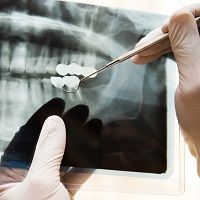Jaw Osteonecrosis as Potential Adverse Effect to Oral Bisphosphonate Therapy
In a review published in the New England Journal of Medicine, Brett noted that the results from the first study suggested that in Taiwan, one out of every 200 patients who are "long-term users of oral alendronate," develop the condition.

Following a recent study of the relationship between patients taking bisphosphonates and the emergence of osteonecrosis of the jaw (ONJ), Allan S. Brett, MD, revisited the topic.
In a review published in the New England Journal of Medicine, Brett noted that the results from the first study suggested that in Taiwan, one out of every 200 patients who are “long-term users of oral alendronate,” develop the condition.
Brett said symptoms of ONJ include “exposed necrotic bone that persists for weeks or months; it can occur spontaneously or after invasive dental procedures.” He added, “The condition was noted initially after high-dose intravenous bisphosphonate treatments for malignant conditions, but some evidence suggests it can develop in users of oral bisphosphonate for osteoporosis.
The original study looked at a pool of 7,332 patients who were taking the medication, alendronate. Of that group just 40 were diagnosed with ONJ, approximately 4 years after beginning the prescription. Obtaining data from a database through a hospital pharmacy the study looked at “radiographic, operative, and pathology reports.”
A similarly collected control group was monitored with 1882 patients afflicted with osteoporosis who were treated with raloxifene, which is a non-bisphosphonate. Results from that group showed just one case of ONJ. Brett said comparing the 2 groups and several factors, the alendronate group was 7 times more likely to develop ONJ.
He also noted that risk factors with the bisphosphonates included diabetes, rheumatoid arthritis, older age, and having taken alendronate for more than 3 years.
While the relationship between bisphosphonates and osteonecrosis has shifted its focus in the past few years to atypical femur fractures associated with the medication, Brett noted, “This new study provides additional support for jaw osteonecrosis as a likely — although uncommon – adverse effect of oral bisphosphonate therapy.”
